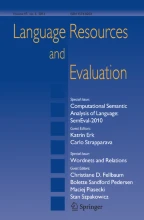Abstract
Although some progress has been made on the quality of Machine Translation in recent years, there is still a significant potential for quality improvement. There has also been a shift in paradigm of machine translation, from “classical” rule-based systems like METAL or LMT1 towards example-based or statistical MT.2 It seems to be time now to evaluate the progress and compare the results of these efforts, and draw conclusions for further improvements of MT quality.
The paper starts with a comparison between statistical MT (henceforth: SMT) and rule-based MT (henceforth: RMT) systems, and describes the set-up and the evaluation results; the second section analyses the strengths and weaknesses of the respective approaches, and the third one discusses models of an architecture for a hybrid system.
Similar content being viewed by others
References
Amtrup J.W., Megerdoomian K., Zajac R. (2000) Rapid Development of Translation Tools: Application to Persian and Turkish. Proc. COLING.
Atkins S., Bouillon P. (2002) The Lexicographic Approach: Sense Indicators as Candidates for Transfer Conditions. Proc. ISLE Workshop Pisa.
Babych B., Hartley A. (2003) Improving Machine Translation Quality with Automatic Named Entity Recognition. Proc. EACL-EAMT, Budapest.
Bel N., Busa F., Calzolari N., Gola E., Lenci A., Monacchini M., Ogonowski A., Peters I., Peters W., Ruimy N., Villegas M., Zampolli A. (2000) SIMPLE: A General Framework for the Development of Multilingual Lexicons. Proc. LREC 2000, Athens.
Bernardi U., Gieselmann P., McLaughlin St. (2001) A Taste of MALT. Proc. MT Summit, Santiago di Compostella.
Buschbeck B., Henschel R., Höser I., Klimonow G., Küstner A., Starke I. (1990) VIRTEX – a German–Russian Translation Experiment. Proceedings of COLING-90, Helsinki.
Calzolari N., Bertagna F., Lenci A., Monachini M. (ed) (2002a) Standards and best practice for multilingual computational Lexicons and MILE (the Multilingual ISLE Lexical Entry). ISLE-Report 2002.
Calzolari N. Grishman R., Palmer M. (2002b). Standards & Best Practice for Multilingual computational lexicons: ISLE MILE and More. Proc. LREC 2002, Gran Canaria.
Chomsky N. (1957) Syntactic Structures. The Hague.
Coughlin D. (2003) Correlating Automated and Human Assessments of Machine Translation Quality. Proc. Machine Translation Summit IX, New Orleans.
Grishman R., Sterling J. (1992) Acquisition of Selectional Patterns. Proc 14th COLING, Nantes.
E. Hovy M. King A. Popescu-Belis (2002) ArticleTitlePrinciples of Context-Based Machine Translation Evaluation Machine Translation 17 IssueID1 19–51 Occurrence Handle10.1023/A:1025510524115
K. Jablonski A. Rau J. Ritzke (1990) Wissensbasierte Textgenerierung Tübingen Narr
King M., Popescu-Belis A., Hovy E. (2003) FEMTI: Creating and using a Framework for MT Evaluation, Proc. Machine Translation Summit IX, New Orleans.
Knight K., Koehn Ph. (2003) Introduction to Statistical Machine Translation. Tutorial MT Summitt 2003, New Orleans.
McCord M. (1989) A New Version of the Machine Translation System LMT. Lit. and Ling. Computing 4.
Menezes A., Richardson St. (2001) A Best-First Alignment Algorithm for Automatic Extraction of Transfer Mappings from Bilingual Corpora. Proc. MT Summit VIII, Santiago, Workshop on Example-based Machine Translation.
(NIST, 2001) Automatic Evaluation of Machine Translation Quality Using N-gram Co-Occurrence Statistics. www.nist.gov/speech/tests/mt.
Nießen S., Ney H. (2000) Improving SMT Quality with Morpho-Syntactic Analysis. Proc. COLING.
Och F., Gildea D., Khudanpur S., et al. (2003) Syntax for Statistical Machine Translation. John Hopkins Summer Workshop. www.clsp.jhu.edu/ws03/groups/translate.
Och F., Ney H. (2001) Statistical Multi-Source Translation. Proc. MT Summit VIII, Santiago.
F.J. Och H. Ney (2003) ArticleTitleA Systematic Comparison of Various Statistical Alignment Models Computational Linguistics 29 IssueID1 19–51 Occurrence Handle10.1162/089120103321337421
Papieni K., Roukos S., Ward T., Zhu W.-J. (2002) BLEU: A Method for Automatic Evaluation of Machine Translation. Proc. 40th ACL, Philadelphia.
Piperidis St., Boutsis S., Demiros J. (1997) Automatic Translation Lexicon Generation from Multilingual texts. Proc. AAAI 1997.
Richardson St., Dolan W., Menezes A., Pinkham J. (2001) Achieving Commercial-Quality Translation with Example-Based Methods. Proc MT Summit Santiago di Compostela.
Samiotou A., Kranias L., Papadopoulos G., Asunmaa M., Magnusdottir G. (2004) Exploitation of parallel texts for Populating MT & TM Databases. Proc. LREC, Workshop on The Amazing Utilty of Parallel and Comparable Corpora, Lisbon.
Steiner E., Winter-Thielen J. (1988) On The Semantics of Focus Phenomena in EUROTRA. Proc. COLING, Budapest.
Thurmair Gr. (1990) METAL: Computer Integrated Translation. Proc. Workshop on Machine Translation, UMIST Manchester.
Thurmair G. (2000) TQPro, Quality Tools for the translation process. Proc. ASLIB, London.
Thurmair G. (2003) Making Term Extraction Tools Usable. Proc EAMT-CLAW Dublin.
Vanni M., Voss C.R., Tate C. (2004) Ground Truth, Referent Truth and “Omniscient” Truth – Parallel Phrases in Parallel Texts for MT Evaluation. Proc. LREC, Workshop on The Amazing Utilty of Parallel and Comparable Corpora, Lisbon.
Vogel S., Och F, Ney H. (2000) The Statistical translation Module in the Verbmobil System. Proc. KONVENS Ilmenau.
S. Vogel F. Och Chr. Tillmann S. Nießen H. Sawaf H. Ney (2000) Statistical Methods for Machine Translation W. Wahlster (Eds) Verbmobil: Foundations of Speech-to-Speech Translation Springer Berlin
Weber N. (2003) MÜ-Lexikografie. Proc. GLDV, Köthen.
Whitelock P. (1992) Shake-and-bake Translation. Proc. COLING Nantes.
Author information
Authors and Affiliations
Corresponding author
Rights and permissions
About this article
Cite this article
Thurmair, G. Hybrid Architectures for Machine Translation Systems. Language Res Eval 39, 91–108 (2005). https://doi.org/10.1007/s10579-005-2698-z
Issue Date:
DOI: https://doi.org/10.1007/s10579-005-2698-z
